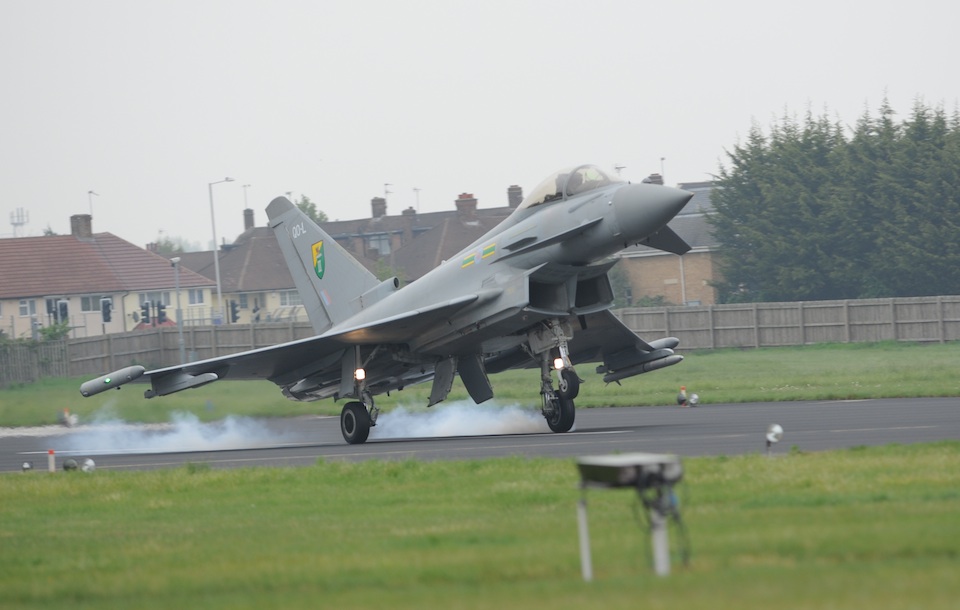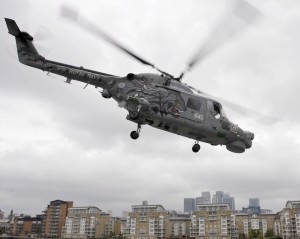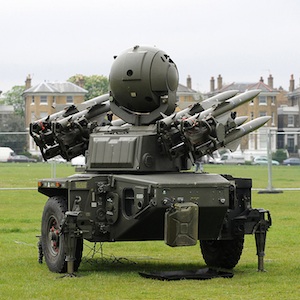

The primary form of air defense is provided by RAF Typhoon aircraft which will form the outer ring of defense outside London. They will be assisted by Royal Navy Lynx and RAF Puma helicopters armed with snipers with Ground Based Air Defense forming the final line of security. Under the Air Security Plan, 30-miles (48km) of airspace surrounding the Olympic Park would become a restricted flying zone.
The Air Security Plan for the Olympic Games builds on the Royal Air Force’s existing defense of UK airspace, which includes round-the-clock radar surveillance and Typhoon fighters held at high readiness 24/7. The exercise integrates the additional forces being used to ensure the safety of the Olympics, as part of the Ministry of Defence’s role to ensure a safe and secure Games this summer.
These include the Typhoon fighter jets that arrived at RAF Northolt on Wednesday May 2nd, (the first time fighter planes are stationed at the base since the end of World War II). They are testing the procedures military aircrews will use to intercept and communicate with aircraft breaching the restricted airspace during the Olympic Games. It will also evaluate the actions pilots must take in response. Pilots entering the restricted airspace can expect to be intercepted by Typhoon fighters, or military helicopters.

RAF Puma helicopters, along with Royal Navy and Army Lynx, carrying teams of RAF Regiment snipers will be on high alert to intercept intruders into restricted airspace, while airborne surveillance by RAF E-3D Sentry Airborne Early Warning & Control (AWACS) and Royal Navy Sea King ASACS (Airborne Surveillance and Control System) provide integration and airspace control.
On the ground, the RAF is providing further mobile ground radar systems (Type 101 radar), while the Army is deploying air observers at 14 additional locations. High Velocity Missile (HVM) and Rapier missile systems will also provide radar detection and active defense capability, to provide additional layers of early warning and low-level air-defense coverage. These Rapier and Starstreak High Velocity Missiles (HVM) air defense systems were also deployed in six sites in and around London.

While aircraft activity over the urban area is expected to increase, Air Vice-Marshal Stuart Atha, Air Component Commander for Olympics Air Security assured the disturbance to the public will be minimal: “We have sought to limit the amount of flying to the minimum required to ensure that our Forces are ready for their important role delivering air security for the Olympics, balancing this against the need for us to reduce disturbance to a minimum.

On May 4th the Royal Navy’s largest warship HMS Ocean has arrived on the River Thames in preparation for the London Olympics. Berthed at Greenwich, the ship will act as a launch pad for four Royal Navy Lynx helicopters and four Army Air Corps Lynx which will patrol the airspace over the capital. Royal Marines snipers from 539 Assault Squadron and 43 Commando will be on board the Navy Lynx helicopters, ready to shoot out the engines of suspicious vessels on the water while RAF Regiment snipers will do the same from the Army Lynx against light aircraft intruding.
P2000 patrol vessels sailing the Thames river are set to ensure safety and security and will investigate any unknown craft or people on the water. Air security will be tested throughout the weekend during the exercise while river operations are set to take place from Tuesday.
Captain Andrew Bretton, Commanding Officer of HMS Ocean said: “As a former Commanding Officer of HMS Westminster, a ship with such great links to London, I am particularly pleased to be bringing HMS Ocean to Greenwich to be part of the Olympics, a truly once-in-a-generation event.” HMS Ocean is the largest ship in the Royal Navy and is ideally suited to the task of supporting the police in providing security for the world’s largest and most famous sporting event. Captain Bretton said.

Olympic Guardian also saw Fleet Flagship HMS Bulwark stage her own security rehearsals ahead of the Olympic sailing competition off Weymouth Bay and Portland Harbor. HMS Bulwark will act as the command platform during the Olympics for the Dorset Police Authority as well as representatives from the Maritime Coastguard Agency (MCA), RNLI and regional civil authorities. Royal Navy bomb disposal experts will be on board and are set to ensure the area is safe for sailing while Merlin helicopters from 814 Naval Air Squadron and embarked Royal Marines will ensure safety from the skies.
As part of their exercise, the team on board HMS Bulwark practiced their communications systems and ran through the workings of the airborne and surface assets. HMS Bulwark’s Commanding Officer Captain Alex Burton is responsible for the military presence in Dorset during the Games.
















